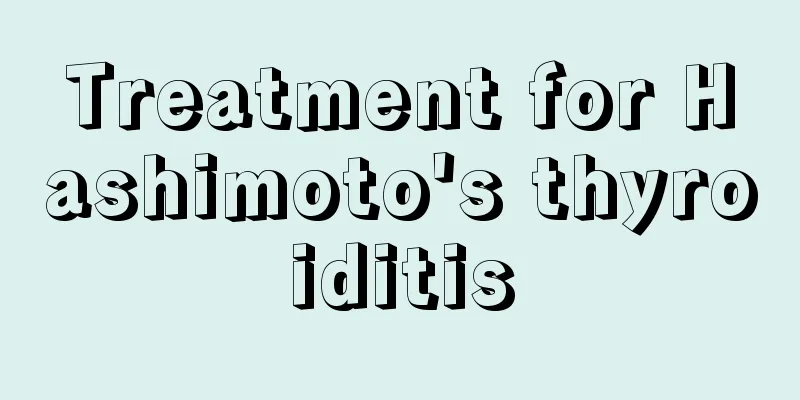Treatment for Hashimoto's thyroiditis

|
I believe many of my friends have heard of thyroiditis. The cause of this disease is mostly due to a lack of iodine or an excess of iodine in the patient's body. As for Hashimoto's thyroiditis, many friends don't know much about the cause of this disease. In fact, this disease is a type of thyroiditis. So for this disease, many friends don't know how to treat it, so let us take a detailed look at how to treat Hashimoto's thyroiditis. Hashimoto's thyroiditis is a chronic disease of abnormal thyroid structure and function caused by autoimmune dysfunction, which causes the body's defense system to be unable to correctly identify its own thyroid tissue and launches an erroneous attack on it. It is called Hashimoto's thyroiditis (HT) because it is named after the Japanese medical professor Hashimoto who first reported the disease. 1. Non-surgical treatment (1) Thyroxine treatment: When the thyroid gland is significantly enlarged or accompanied by hypothyroidism, thyroxine treatment can be given. L-T4 or thyroid powder (tablets) can be used. Generally, it starts with a low dose, 40-60 mg/d of thyroxine tablets, 50-100 μg/d of L-T4, and gradually increases the dose to 120-180 mg/d or 100-200 μg/d, respectively, until the gland begins to shrink and the TSH level drops to normal. After that, the dosage is gradually adjusted according to individual differences, and the dosage is reduced to a maintenance dose based on thyroid function and TSH levels. The course of treatment is generally 1 to 2 years. The medication can be stopped after the goiter improves and thyroid function returns to normal. Generally speaking, the more obvious the thyroid enlargement, the more significant the treatment effect. Some patients may relapse within a few years after stopping medication and can be given thyroxine treatment again. Most CLT patients have a tendency to develop hypothyroidism, so follow-up examinations should be paid attention to, and treatment should be given when hypothyroidism occurs. (2) Antithyroid treatment: Hashimoto's hyperthyroidism should be treated with antithyroid treatment, which can be treated with methimazole (methimazole) or propylthiouracil (PTU), but the dose should be lower than that used to treat Graves' disease, and the medication should not be taken for too long. If it is transient hyperthyroidism (clinical manifestation type), symptomatic treatment can be carried out with only beta-blockers, such as propranolol (Inderal) or metoprolol (Betaloc). According to surveys and research, Hashimoto's thyroiditis mostly occurs in women. We all know that when people suffer from thyroiditis, swelling usually occurs in the neck, but when this happens, the condition is already quite serious. Therefore, it is recommended that people have a physical examination every year to prevent physical illness. Nowadays, the cure rate for Hashimoto's thyroiditis is very high, so patients do not need to worry too much. |
<<: How to treat fire in pregnant women
>>: What to do when pregnant women have internal heat
Recommend
Is “supplementing what is lacking” precise nutrition? This is the key to cracking the code of longevity!
With the continuous deepening of the "Health...
How to deal with milk knots for several years
Milk knots appear after weaning. This situation i...
How many months of breastfeeding do you lose weight faster?
Pregnant women, after ten months of pregnancy, fi...
Armpit odor after childbirth
In the summer, people wear fewer clothes, and we ...
Why does vaginal itching occur after menstruation?
Generally, for vulvar itching, doctors need to do...
What to eat when ovarian function is not good?
The ovaries play the important role of secreting ...
Postpartum leucorrhea like yellow mucus
Postpartum leucorrhea is yellow and looks like ru...
How long after giving birth can I achieve vaginal tightening? How to exercise for vaginal tightening after childbirth
Women will go through a long period of "conf...
Does stringy leucorrhea during ovulation mean ovulation? Why does stringy leucorrhea occur during ovulation?
We all know that women who are trying to get preg...
Can I have a color Doppler ultrasound during my menstrual period? The correct approach is this
People often go for color ultrasound examinations...
Female urethral swelling
The urethra is an important part of the urogenita...
Why does a woman's vagina smell?
Unpleasant body odor is a symptom that many women...
How much does a premature baby weigh at 31 weeks?
Pregnant women are very concerned about the weigh...
Are adnexitis and pelvic inflammatory disease serious?
Adnexitis and pelvic inflammatory disease are two...









